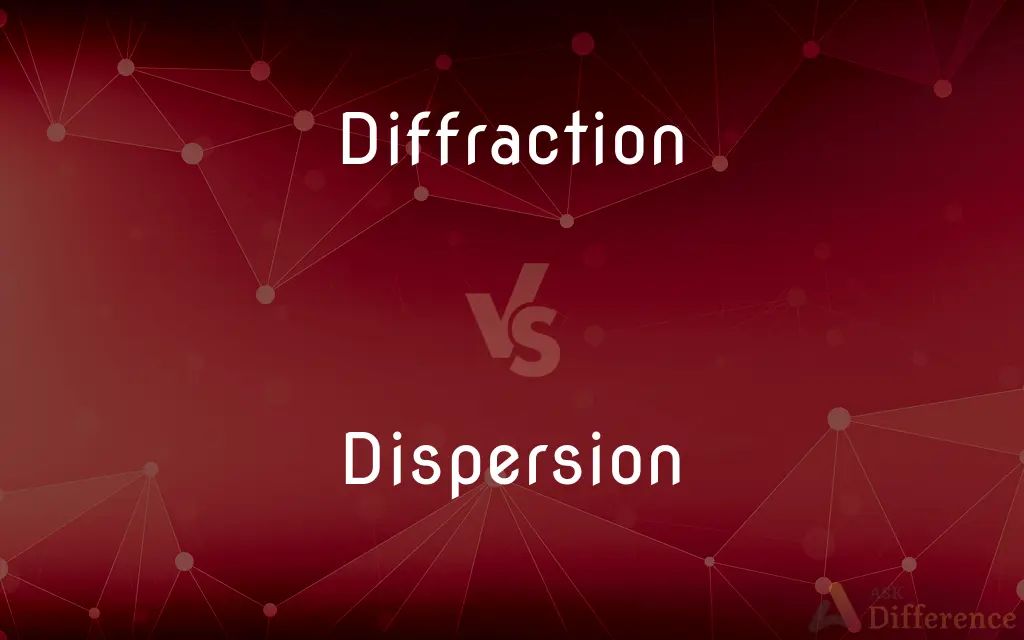Diffraction vs. Dispersion — What's the Difference?
By Urooj Arif & Maham Liaqat — Updated on April 8, 2024
Diffraction involves the bending and spreading of waves around obstacles, while dispersion refers to the separation of a wave into its component frequencies or colors.

Difference Between Diffraction and Dispersion
Table of Contents
ADVERTISEMENT
Key Differences
Diffraction is a wave phenomenon where waves, such as light, sound, or water waves, bend around the edges of an obstacle or through openings, creating a pattern of constructive and destructive interference. On the other hand, dispersion occurs when a wave, particularly light, passes through a medium and its constituent colors or frequencies spread out due to varying speeds.
In the context of light, diffraction can result in various patterns, such as fringes, due to interference of the bent waves. Whereas, dispersion in light is famously observed as a rainbow, where sunlight is dispersed by raindrops, separating light into its spectral colors.
Diffraction effects are most pronounced when the wavelength of the wave is comparable to the size of the obstacle or opening. Meanwhile, dispersion is more about the material properties through which the wave travels, with different frequencies of the wave traveling at different speeds.
An example of diffraction includes the spreading of sound waves around corners, allowing you to hear sounds even if the source is not directly visible. On the contrary, an example of dispersion is seen when light passes through a prism, spreading out into its component colors.
The study of diffraction is crucial in understanding wave behavior in various applications, such as optical instruments and antenna design. Dispersion, however, is essential in fields like spectroscopy, where it is used to analyze the composition of materials by separating light into its colors.
ADVERTISEMENT
Comparison Chart
Definition
Bending of waves around obstacles or through openings.
Separation of a wave into components due to different speeds.
Observed in
Waves like light, sound, and water.
Mainly in light waves, but can occur in other waves too.
Dependent Factors
Wavelength and obstacle size.
Material properties and wave frequency.
Common Examples
Light patterns through a slit, sound around corners.
Rainbows, light through a prism.
Importance in Science
Used in designing optical instruments, studying wave nature.
Crucial for spectroscopy, analyzing light properties.
Compare with Definitions
Diffraction
A phenomenon that causes waves to spread out.
Sound waves diffract around buildings, making it possible to hear around corners.
Dispersion
Results from speed variation in a medium.
Light speeds vary in glass, causing dispersion.
Diffraction
The bending of waves around obstacles.
Light passing through a small aperture creates a diffraction pattern.
Dispersion
The separation of a wave into its component frequencies.
A prism dispersing sunlight into a spectrum.
Diffraction
Observed in all types of waves.
Water waves spreading out after passing through a narrow gap.
Dispersion
Material property dependent.
Different glasses disperse light to different extents.
Diffraction
Creates interference patterns.
Laser light through a double slit produces a series of bright and dark fringes.
Dispersion
Observed primarily in light.
Rainbows are natural examples of dispersion.
Diffraction
Dependent on the wavelength relative to obstacle size.
Longer wavelengths diffract more noticeably.
Dispersion
Used in spectroscopy.
Dispersion allows the analysis of substances based on their spectral lines.
Diffraction
Diffraction refers to various phenomena that occur when a wave encounters an obstacle or opening. It is defined as the bending of waves around the corners of an obstacle or through an aperture into the region of geometrical shadow of the obstacle/aperture.
Dispersion
The action or process of distributing things or people over a wide area
Some seeds rely on birds for dispersion
Diffraction
Change or dispersion of the direction and intensity of a wave as it traverses an object or aperture, especially when the size of the object or aperture approximates the wavelength of the wave.
Dispersion
The separation of white light into colours or of any radiation according to wavelength.
Diffraction
(physics) The bending of a wave around an obstacle.
Dispersion
The extent to which values of a variable differ from a fixed value such as the mean.
Diffraction
(quantum mechanics) The breaking up of an electromagnetic wave as it passes a geometric structure (e.g. a slit), followed by reconstruction of the wave by interference.
Dispersion
The act or process of dispersing.
Diffraction
The deflection and decomposition of light in passing by the edges of opaque bodies or through narrow slits, causing the appearance of parallel bands or fringes of prismatic colors, as by the action of a grating of fine lines or bars.
Remarked by Grimaldi (1665), and referred by him to a property of light which he called diffraction.
Dispersion
The state of being dispersed.
Diffraction
When light passes sharp edges or goes through narrow slits the rays are deflected and produce fringes of light and dark bands
Dispersion
Dispersion The Diaspora of the Jews.
Dispersion
(Statistics) The degree of scatter of data, usually about an average value, such as the median.
Dispersion
Separation of a complex wave into its component parts according to a given characteristic, such as frequency or wavelength.
Dispersion
Separation of visible light into colors by refraction or diffraction.
Dispersion
(Chemistry) See disperse system.
Dispersion
The state of being dispersed; dispersedness.
Dispersion
A process of dispersing.
Dispersion
The degree of scatter of data.
Dispersion
(optics) The separation of visible light by refraction or diffraction.
Dispersion
(medicine) The removal of inflammation.
Dispersion
The act or process of scattering or dispersing, or the state of being scattered or separated; as, the Jews in their dispersion retained their rites and ceremonies; a great dispersion of the human family took place at the building of Babel.
The days of your slaughter and of your dispersions are accomplished.
Dispersion
The separation of light into its different colored rays, arising from their different refrangibilities.
Dispersion
Spreading widely or driving off
Dispersion
The spatial property of being scattered about over an area or volume
Dispersion
The act of dispersing or diffusing something;
The dispersion of the troops
The diffusion of knowledge
Common Curiosities
How are diffraction and dispersion similar?
Both are wave phenomena that alter the propagation path or composition of waves.
How do diffraction and dispersion differ in light?
Diffraction causes light to spread out and create patterns, while dispersion separates white light into its colors.
What causes dispersion?
Dispersion is caused by the varying speeds of different frequencies of waves in a medium.
How does wavelength affect diffraction?
The amount of diffraction increases with wavelength relative to the obstacle size.
What is dispersion?
Dispersion is the separation of a wave into its components due to different speeds in a medium.
How does a prism demonstrate dispersion?
A prism separates white light into its component colors by dispersion, showing a visible spectrum.
What is diffraction?
Diffraction is the bending and spreading of waves around obstacles or through openings.
What causes diffraction?
Diffraction is caused by the wave nature of light, sound, or other waves interacting with obstacles or slits.
Why is dispersion significant in science?
Dispersion is crucial for spectroscopy and studying material compositions through their spectral signatures.
How does the medium affect dispersion?
Different mediums disperse waves differently, based on their material properties and the wave's frequency.
Can diffraction occur with sound waves?
Yes, diffraction occurs with sound waves, allowing sound to bend around obstacles.
Is dispersion only observed with light?
While most commonly associated with light, dispersion can occur with any wave type.
Can diffraction create color patterns?
Diffraction patterns are more about interference and may not directly result in color separation, unlike dispersion.
Why is diffraction important in technology?
It is essential in the design and analysis of optical instruments, antennas, and understanding wave properties.
What are practical applications of diffraction and dispersion?
Diffraction is used in optical engineering and acoustics, while dispersion is utilized in spectroscopy and optical devices.
Share Your Discovery

Previous Comparison
Scarce vs. Scarcely
Next Comparison
Reviewee vs. ReviewAuthor Spotlight
Written by
Urooj ArifUrooj is a skilled content writer at Ask Difference, known for her exceptional ability to simplify complex topics into engaging and informative content. With a passion for research and a flair for clear, concise writing, she consistently delivers articles that resonate with our diverse audience.
Co-written by
Maham Liaqat











































